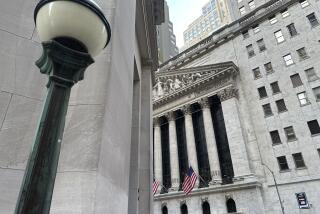Fed Raises Rates Again; Markets Shake It Off
- Share via
Wall Street reacted to the Federal Reserve’s latest interest rate boost with a rally Tuesday--probably not what policymakers were hoping for.
Key stock indexes zoomed, with the Standard & Poor’s 500 surging 2.6% to a record 1,493.87, the first new high for the blue-chip index since Dec. 31.
Likewise, the Dow Jones industrials gained 227.10 points, or 2.1%, to 10,907.34, continuing the rebound in “old economy” stocks that began last week.
The tech-dominated Nasdaq index also shot up, gaining 2.2% to 4,711.68 after a steep morning slide.
Meanwhile, the 30-year Treasury bond yield slipped to 5.97% from 6% on Monday--the bond’s first finish below 6% since September.
Fed Chairman Alan Greenspan has repeatedly cited the “wealth effect” from stocks’ bull market as a reason policymakers must raise rates to dampen economic growth. For much of this year, old-economy stocks seemed to be heeding the Fed, as the Dow tumbled. But the new-economy Nasdaq index roared ahead.
Last week, the Dow resurged while investors cashed in some profits on Nasdaq. On Tuesday, however, both old- and new-economy stocks gained--a situation which, if it continues, could just deepen the Fed’s concerns about the wealth effect.
Bank stocks were hot Tuesday, but so were many major tech shares. Energy stocks rose, but so did many Internet names.
Although falling stocks still outnumbered winners on Nasdaq, the heaviest selling was in the biotech sector, which had been one of the strongest stock groups this year. Visible Genetics, for example, fell $11.38 to $57.50 on Tuesday, but is still up 92% year-to-date.
Some analysts say investors may simply be betting that the Fed will succeed in eventually slowing the economy without inducing recession. Expectations for a sustained economic expansion would encourage investors to remain in equities, experts note.
“The good news is that a couple more hikes will not derail the economy,” argues Alfred Goldman, market strategist at brokerage A.G. Edwards in St. Louis.
Analysts also say that the continuing rally in the Treasury bond market may be providing a solid underpinning for stocks.
But the bond market, like the stock market, has been a split story for much of this year, frustrating those who watch bond yields for signals on the broader economy.
The 30-year T-bond has mostly been tumbling since peaking at 6.75% on Jan. 18. At 5.97%, the 30-year T-bond now is below the 6.5% yield on 2-year T-notes--and even below the Fed’s shortest-term rate, now at 6%.
When long-term yields fall below shorter ones, it’s often a sign that the markets anticipate a slowing economy.
But many experts say that long-term Treasury yields are responding less to economic conditions than to supply constraints: Thanks to the federal budget surplus, the Treasury is borrowing less--that is, issuing fewer bonds--and is buying back some of the longer-term bonds already on the market.
With investors competing for a shrinking supply of bonds, yields are dropping.
“The government securities market is trading in a world of its own because of the supply dynamics,” said Dana Johnson, chief of research at Banc One Capital Markets in Chicago.
He noted that, unlike in the Treasury market, yields in the “interest-rate swaps” market are still positively sloped--that is, rising from shorter-term to longer.
“That is much more indicative that people don’t see the economy slowing down,” Johnson said.
Another sign: Rates on corporate bonds and on mortgages have dipped only slightly from their peaks reached in mid-February.
Yet even with mortgage rates 1.5 percentage points above last spring’s level, construction spending, housing starts and other measures of real-estate activity continue strong, noted economist Richard Yamarone of Argus Research in New York.
But there are some signs that investors are growing more cautious about the economy. The corporate junk-bond market--always sensitive to economic trends--is showing some signs of distress, said Martin S. Fridson, chief high-yield strategist at Merrill Lynch.
Defaults have risen, and the “spread” between junk yields and Treasury yields has widened.
Market Roundup, C10
(BEGIN TEXT OF INFOBOX / INFOGRAPHIC)
Bond Yields: A Split Picture
The Federal Reserve raised its key short-term interest rate from 5.75% to 6% on Tuesday, in another move to slow the economy. Fear of the Fed--and the economy’s surprising resilience--are keeping rates on mortgages and corporate bonds near four-year highs. Only Treasury bond yields are sliding, mainly because Uncle Sam is buying back debt. Weekly closes and latest for key yields:
*
Source: Bloomberg News
More to Read
Inside the business of entertainment
The Wide Shot brings you news, analysis and insights on everything from streaming wars to production — and what it all means for the future.
You may occasionally receive promotional content from the Los Angeles Times.










